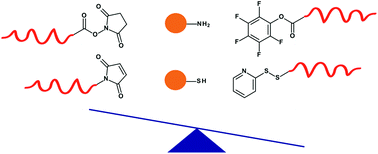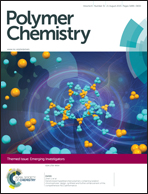Polymer-protein conjugation via a ‘grafting to’ approach – a comparative study of the performance of protein-reactive RAFT chain transfer agents†
Abstract
Efficient polymer-protein conjugation is a crucial step in the design of many therapeutic protein formulations including nanoscopic vaccine formulations, antibody-drug conjugates and to enhance the in vivo behaviour of proteins. Here we aimed at preparing well-defined polymers for conjugation to proteins by reversible addition–fragmentation chain transfer (RAFT) polymerization of both acrylates and methacrylamides with protein-reactive chain transfer agents (CTAs). These RAFT agents contain either a N-hydroxysuccinimide (NHS) or pentafluorophenyl (PFP) ester moiety that can be conjugated to lysine residues, and alternatively a maleimide (MAL) or pyridyl disulfide (PDS) moiety that can be conjugated to cysteine residues. Efficiency of the bioconjugation of these polymers to bovine and avian serum albumin was investigated as a function of stoichiometry, polymer molecular weight and the presence of reducing agents. A large molar excess of polymer was required to obtain an acceptable degree of protein conjugation. However, protein modification with N-succinimidyl-S-acetylthiopropionate (SATP) to introduce sulfhydryl groups onto primary amines, significantly increased conjugation efficiency with MAL- and PDS-containing polymers.

- This article is part of the themed collection: Emerging Investigators

 Please wait while we load your content...
Please wait while we load your content...